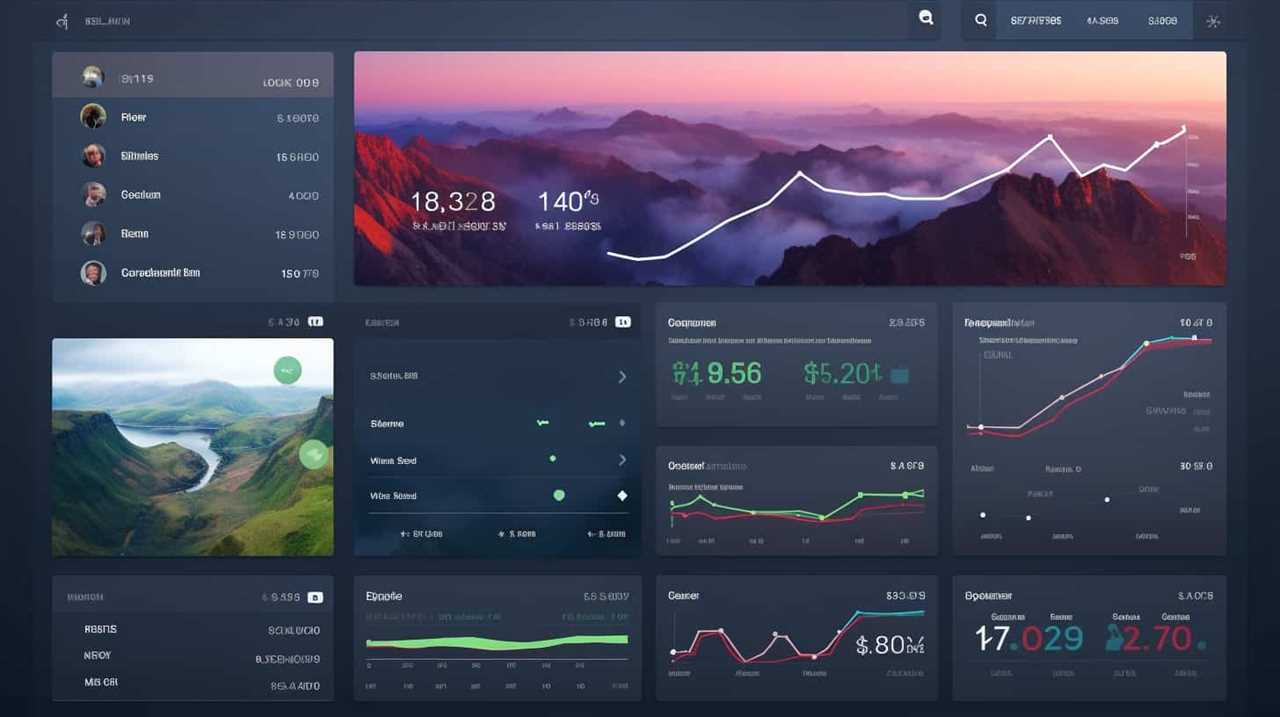We deploy technical SEO techniques to enhance our website’s presence, boost our positions in search engine outcomes, and grow our natural website traffic.
By optimizing our website’s structure and architecture, we enhance user experience and satisfaction. We fix technical errors and issues, ensuring our website is compatible with search engine algorithms.
We also optimize our website for mobile devices, gaining a competitive edge in the digital landscape.
In short, technical SEO enables us to master the art of online visibility and drive success.

Key Takeaways
- Technical SEO enhances website visibility and improves search engine rankings.
- Keyword research and optimization drive organic traffic and increase website rankings.
- Content optimization strategies create engaging and valuable website content, driving organic traffic.
- Website performance and user experience are crucial for improved search engine rankings and conversions.
Enhancing Website Visibility
To enhance our website visibility, we focus on optimizing technical SEO through a combination of strategic keyword research and effective meta tag implementation.
By improving website accessibility, we ensure that our site is easily navigable for all users, including those with disabilities. This includes incorporating alt text for images, providing clear headings and subheadings, and optimizing page loading times.
We also prioritize maximizing website conversions by creating compelling calls-to-action, optimizing landing pages, and streamlining the checkout process.
Through continuous data analysis and A/B testing, we identify areas for improvement and make data-driven decisions to enhance the user experience and increase conversion rates.

Improving Search Engine Rankings
When it comes to improving search engine rankings, there are two key points to consider: keyword optimization techniques and backlink building strategies.
By strategically incorporating relevant keywords into your website content and meta tags, you can increase your chances of ranking higher in search engine results.
Additionally, building high-quality backlinks from authoritative websites can also help improve your website’s visibility and credibility in the eyes of search engines.
Keyword Optimization Techniques
Keyword optimization techniques play a crucial role in improving our search engine rankings. To achieve success in this area, we must focus on two key aspects:

- On-page optimization techniques: This involves optimizing our website’s content, such as using relevant keywords in our meta tags, headlines, and body text. Additionally, we need to ensure our website is properly structured with user-friendly URLs, informative alt tags for images, and optimized internal linking.
- Off-page optimization strategies: These strategies involve building high-quality backlinks from authoritative websites. This can be achieved through guest blogging, influencer outreach, and social media promotion. By obtaining backlinks from reputable sources, we can increase our website’s credibility and visibility in search engine rankings.
With these keyword optimization techniques in place, we can effectively enhance our website’s visibility and organic traffic.
Now, let’s explore the next section on backlink building strategies.
Backlink Building Strategies
After implementing effective keyword optimization techniques, we can now delve into backlink building strategies to further improve our search engine rankings.
Building high-quality backlinks is crucial for increasing our website’s visibility and authority in the eyes of search engines. To achieve this, we need to focus on implementing proven link building techniques and effective outreach strategies.

One effective approach is to identify authoritative websites in our niche and reach out to them for collaboration or guest posting opportunities.
Another strategy is to create valuable and shareable content that naturally attracts backlinks from other websites.
Additionally, participating in industry forums and online communities can help us build relationships and gain backlinks from trusted sources.
Increasing Organic Website Traffic
To increase organic website traffic, we need to implement SEO best practices, such as optimizing our website for search engines.

This includes conducting keyword research to identify the most relevant and high-performing keywords to target in our content.
SEO Best Practices
Improving website traffic organically is achieved by implementing SEO best practices.
To increase organic website traffic, it’s crucial to conduct regular SEO audits to identify areas for improvement. These audits help uncover technical issues and optimize website performance.
On-page optimization is another essential SEO best practice that focuses on optimizing individual web pages to rank higher in search engine results. This involves optimizing meta tags, header tags, and keyword usage to make the content more accessible and relevant to search engines.

Additionally, it’s important to prioritize user experience by improving website speed, enhancing mobile responsiveness, and optimizing site navigation.
Keyword Research Importance
Keyword research is essential for increasing organic website traffic and is a crucial step in our technical SEO process. By conducting thorough keyword research, we can identify the most relevant and high-performing keywords that our target audience is searching for. This allows us to optimize our website content and improve its visibility in search engine results.
In addition to targeting broad keywords, we also focus on long tail keywords, which are longer and more specific keyword phrases. These long tail keywords often have lower search volume but higher conversion rates, making them valuable for driving targeted traffic to our website.
Furthermore, competitive analysis helps us understand which keywords our competitors are targeting and allows us to find opportunities to outperform them. By incorporating long tail keywords and leveraging competitive analysis, we can significantly increase our organic website traffic.

Now, let’s explore content optimization strategies to further enhance our SEO efforts.
Content Optimization Strategies
Our approach to content optimization is to focus on creating engaging and valuable website content that drives organic traffic. By following effective content creation and on-page optimization strategies, we aim to increase the visibility and relevance of our website in search engine results.
Here are two key strategies we employ:
- Keyword research: We conduct thorough keyword research to identify relevant and high-performing keywords that align with our target audience’s search intent. This helps us optimize our content by incorporating these keywords strategically in the title, headings, meta tags, and body text.
- User-centric approach: We prioritize user experience by creating content that provides value, answers their questions, and addresses their pain points. This includes using clear and concise language, organizing content with headings and bullet points, and incorporating multimedia elements like images and videos.
Optimizing Website Structure and Architecture
To enhance the performance of our website, we streamline its structure and architecture through optimizing. One crucial aspect of this optimization process is improving the website navigation, which involves creating a clear and intuitive menu structure that allows users to easily find the information they are looking for. Another important factor is the URL structure, which should be concise, descriptive, and keyword-rich to enhance search engine visibility.

To visualize the impact of optimizing website structure and architecture, consider the following table:
| Before Optimization | After Optimization |
|---|---|
| Complex navigation | Simplified navigation |
| Lengthy and unclear URLs | Short and keyword-rich URLs |
| Confusing site hierarchy | Clear and logical site hierarchy |
Enhancing User Experience and Satisfaction
To enhance user experience and satisfaction, we focus on two key factors: page loading speed and mobile-friendly design.
Studies show that slow loading speeds can significantly impact user engagement, with a one-second delay resulting in a 7% reduction in conversions. By optimizing website performance and ensuring quick loading times, we can create a seamless browsing experience that keeps users engaged and satisfied.
Additionally, with the increasing use of mobile devices, having a mobile-friendly design is crucial to providing a positive user experience, as it allows visitors to easily navigate and interact with the website on smaller screens.

Page Loading Speed
Improving page loading speed enhances user experience and satisfaction by reducing wait times. When users visit a website, they expect instant access to its content. Slow loading pages can lead to frustration and abandonment, resulting in a poor user experience. By focusing on page loading speed, we can improve navigation experience and keep users engaged.
To enhance page loading speed, two key factors need to be addressed:
- Optimizing website elements: By compressing images, minifying CSS and JavaScript files, and reducing the number of HTTP requests, we can minimize the file size and load time of a webpage.
- Minimizing server response time: A fast server response time ensures that users can quickly access the requested content. This can be achieved by optimizing server configurations, reducing database queries, and leveraging caching mechanisms.
Mobile-Friendly Design
We frequently prioritize mobile-friendly design to enhance user experience and satisfaction. User experience optimization is crucial in today’s digital landscape, where mobile devices dominate internet usage. Responsive design plays a vital role in ensuring that websites adapt seamlessly to different screen sizes and resolutions, providing a consistent and user-friendly experience across all devices.
Responsive design allows for easy navigation, legible content, and optimized images, resulting in faster load times and reduced bounce rates. With the increasing number of mobile users, neglecting mobile-friendliness can lead to a significant loss in potential traffic and conversions.

Boosting Website Speed and Performance
One of the key aspects in optimizing our website is by enhancing its speed and performance. A fast-loading website not only improves user experience but also contributes to better search engine rankings.
To achieve website performance optimization, we can employ various speed optimization techniques, such as minimizing HTTP requests by combining CSS and JavaScript files, and optimizing images by compressing them without compromising quality.
Another effective technique is caching, where we store static resources on the user’s device, reducing the need for repeated downloads. Additionally, enabling Gzip compression can significantly reduce file sizes, resulting in faster load times.
By implementing these speed optimization techniques, we can ensure that our website loads quickly and efficiently. This sets the foundation for a positive user experience and improved search engine visibility.

Now let’s delve into the next section, which focuses on fixing technical errors and issues.
Fixing Technical Errors and Issues
To address technical errors and issues, we must focus on resolving any underlying problems that may hinder website performance and hinder search engine optimization efforts. Fixing technical issues is a critical aspect of website maintenance, as these issues can negatively impact user experience and search engine rankings.
By identifying and resolving technical errors, we can ensure that our website functions efficiently and provides a seamless user experience. This includes addressing issues such as broken links, slow page load times, duplicate content, and crawl errors.
Regularly conducting technical audits and monitoring our website’s performance allows us to proactively identify and fix any technical issues that may arise. By prioritizing the resolution of these issues, we can improve our website’s visibility, usability, and overall performance.

Ensuring Website Compatibility With Search Engine Algorithms
To ensure website compatibility with search engine algorithms, we prioritize optimizing our site’s technical elements. This is crucial because search engines rely on various factors to determine a website’s ranking and visibility. By focusing on website performance, we can enhance user experience and improve search engine crawlability.
Here are two key steps we take to ensure compatibility:
- Optimizing page speed: We analyze and optimize our website’s loading speed to provide a smooth and efficient user experience. This includes compressing images, minifying CSS and JavaScript files, and leveraging caching techniques.
- Implementing structured data: We use structured data markup, such as Schema.org, to provide search engines with additional context about our content. This allows search engine algorithms to better understand and interpret our website’s information.
Optimizing Website for Mobile Devices
To optimize our website for mobile devices, we prioritize enhancing its responsiveness and user-friendly interface. This involves implementing responsive design, a technique that allows the website to adapt and adjust its layout based on the size and orientation of the user’s device.
By utilizing responsive design, we ensure that our website delivers a consistent and optimal experience across different screen sizes and resolutions.

Additionally, we employ various mobile optimization techniques to further enhance the performance and usability of our website on mobile devices. These techniques may include optimizing images and videos for faster loading times, minimizing the use of pop-ups and interstitials, and simplifying navigation menus for easier touchscreen interaction.
Gaining a Competitive Edge in the Digital Landscape
In order to gain a competitive edge in the digital landscape, we focus on implementing strategic technical SEO practices. By analyzing our competitors’ digital marketing strategies, we can identify areas where we can improve and surpass them. This allows us to stay ahead in the ever-evolving world of online marketing.
To achieve this, we conduct thorough competitor analysis, examining their website structure, content optimization, and keyword targeting. This helps us understand their strengths and weaknesses, enabling us to refine our own strategies and outperform them.
Additionally, we prioritize user experience by optimizing our website for mobile devices. With the majority of internet users accessing content through smartphones and tablets, it’s crucial to have a mobile-friendly website to attract and retain visitors.

Frequently Asked Questions
How Do I Choose the Right Keywords for My Website?
When choosing keywords for our website, we rely on keyword research tools to identify long tail keywords that align with our content strategy. This data-driven approach helps us optimize our website for maximum visibility and relevance.
What Is the Role of Backlinks in Technical Seo?
The importance of backlinks in technical SEO cannot be overstated. Building high quality backlinks is essential for better SEO performance. They help search engines understand the credibility and authority of our website.
How Can I Optimize My Website for Voice Search?
We optimize our website for voice search by prioritizing mobile responsiveness. This is important because voice search is becoming increasingly popular and mobile devices are the primary means of accessing the internet.
What Are the Best Practices for Optimizing Images on My Website?
Image optimization techniques are crucial for website performance and SEO. Alt tags play a significant role in improving accessibility and search engine visibility. Implementing these best practices enhances user experience and boosts organic rankings.

How Can I Measure the Success of My Technical SEO Efforts?
Measuring technical SEO success requires analyzing SEO performance metrics. For example, tracking organic traffic growth and keyword rankings can indicate the effectiveness of our technical SEO efforts.
Conclusion
In conclusion, technical SEO plays a crucial role in improving website visibility, search engine rankings, and organic traffic. By optimizing website structure, fixing errors, and ensuring compatibility with search engine algorithms, businesses can gain a competitive edge in the digital landscape.
Additionally, enhancing user experience and optimizing for mobile devices further enhance website performance. Through the power of technical SEO, businesses can unlock the full potential of their online presence and create a seamless and satisfying experience for their audience.










